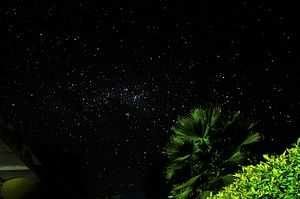A starry night in inland Tanzania

Night or night time(sp.night-timeornight time) is the period from sunset to sunrisein each twenty-four hours[1], when the Sun is below the horizon.
However it can be defined differently and is subjective. Night can be defined as the time between bed time and morning[2]. There is no exact time for when night begins and ends (equally true withevening). The start of night begins when evening ends, which is subjective, but is typically believed to end at astronomical sunset, which is when night may begin. There can be no precise definition in terms of clock time, but it is usually considered to start around 9 pm and to last to about 4 am[3]. Since sunset and sunrise vary through out the year[4]there can be no precise definition in terms of clock time. Night and morning overlap when one considers morning to start past 12 am (however this is subjective and may others consider morning to begin at sunrise)[5], which can be described as 'morning-night duality'.
Night is used as a farewell, 'good night'. And sometimes shortened to 'night'. Unlike 'goodmorning', 'goodafternoon', and 'goodevening', 'good night' is typically not used agreeting.[6]Complete darkness or astronomical nightis the period between astronomical dusk and astronomical dawn when the Sun is between 18 and 90 degrees below the horizon and does not illuminate the sky. As seen from latitudes between 48.5° and 66.5° north or south of the Equator, complete darkness does not occur around the summer solstice because although the Sun sets, it is never more than 18° below the horizon at lower culmination.
The opposite of night is day(or "daytime", to distinguish it from "day" referring to a 24-hour period). The start and end points of time for a night vary, based on factors such asseason,latitude,longitude, andtime zone.Twilightis the period of night after sunset or before sunrise when the Sun still illuminates the sky when it is below the horizon. At any given time, one side of Earthis bathed insunlight(the daytime) while the other side is in the shadow caused by Earth blocking the sunlight. The central part of the shadow is called the umbra.
Natural illumination at night is still provided by a combination of moonlight,planetary light,starlight,zodiacal light,gegenschein, andairglow.
In some circumstances,aurorae,lightning, and bioluminescence can provide some illumination. The glow provided by artificial lighting is sometimes referred to aslight pollution because it can interfere with observational astronomy and ecosystems.
nice article brther! 😉